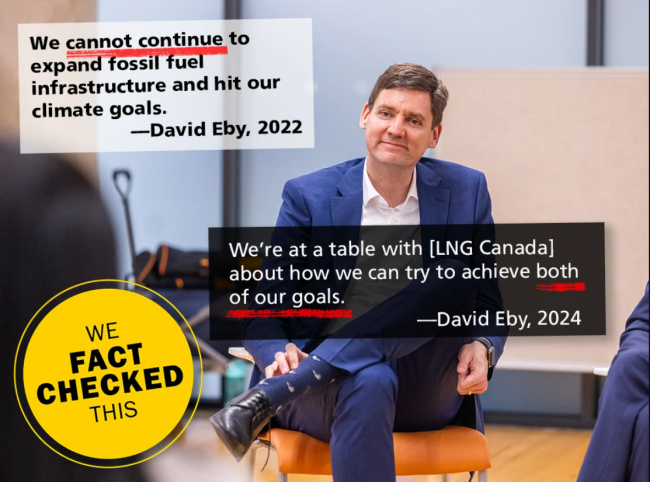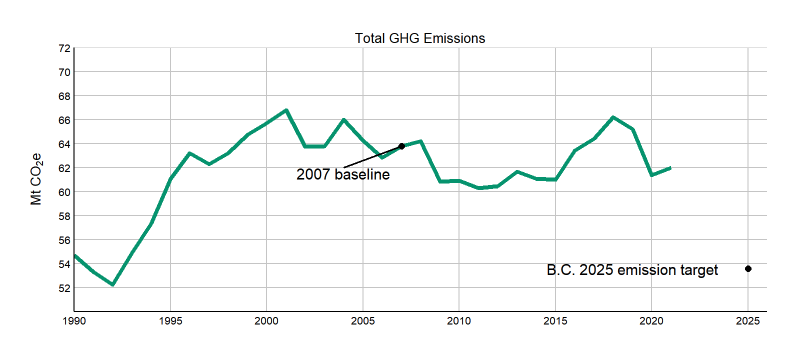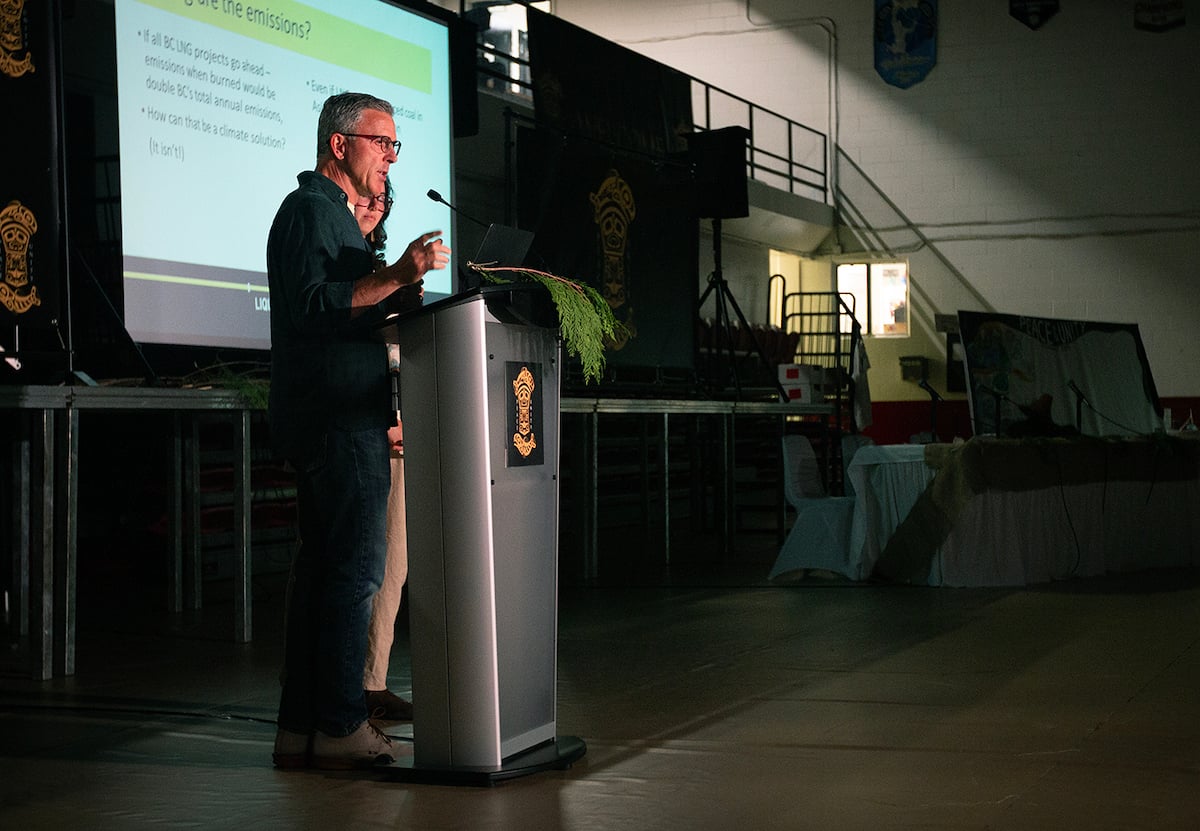Articles Menu

July 23, 2024
B.C. can significantly expand its LNG exports while cutting emissions, Premier David Eby recently told the U.S.-based outlet Bloomberg News.
“We’ve made some pretty clear commitments around driving down emissions in the province, and we’re at a table with them about how we can try to achieve both of our goals,” Eby said about LNG Canada investors Shell, Petronas, PetroChina, Mitsubishi and Korea Gas Corp. “From their perspective, ensuring that reliable, low-carbon energy and, from our perspective, all the emissions not showing up on B.C.’s books as the main producer.”
The remarks are a departure from comments the premier made shortly before taking office in 2022, when Eby told the CBC, “We cannot continue to expand fossil fuel infrastructure and hit our climate goals.” At that time, The Tyee repeatedly asked whether Eby would support future LNG development but did not receive a response.
Speaking at the Peace and Unity Summit, a gathering of northwest First Nations last week in Prince Rupert, John Young, LNG senior strategist with Climate Action Network Canada, criticized the premier’s comments.
“[Eby] understands that... you don’t have to take responsibility for emissions that are not burned in your jurisdiction,” Young said. “You can make as much oil and gas as you want, send it wherever you want to, and wherever they burn it, that’s their problem. Those are their emissions.”
LNG Canada will soon complete the first phase of its export facility. By next year, it’s expected to begin shipping 14 megatonnes of LNG annually to countries abroad. Proponents argue that the gas exports provide a lower-carbon “bridge fuel” as countries like China transition from coal. Critics have disputed the argument.
If LNG Canada decides to go ahead with the project’s second phase, the facility’s capacity will double.
Even if B.C. doesn’t count the roughly 75 megatonnes of carbon emissions that LNG Canada would be unloading overseas every year if it reaches full build-out — an amount that exceeds the current annual emissions for all of B.C. — what are the impacts of producing LNG on carbon emissions here at home?
THE CLAIM: B.C. can reduce its overall emissions as LNG Canada comes online.
FACT CHECK: According to Young, LNG Canada’s first phase “already makes it pretty much impossible” to meet B.C.’s climate goals.
When the facility comes online next year, it will use gas-powered turbines to undertake an energy-intensive process that involves cooling gas to below -160 C to liquefy it. That alone will put a serious dent in B.C.’s carbon emission targets, he said.
According to B.C.’s Energy Ministry, in 2018 each phase of the LNG Canada facility was expected to produce roughly 3.5 megatonnes of carbon a year, including from the export terminal, pipeline and production in B.C.’s northeast. (The ministry added that the estimate does not account for strengthened regulations that are expected to reduce upstream emissions, but it did not provide updated figures.)
That’s about five per cent of the province’s most recently reported overall annual emissions.
But B.C. has also committed to incrementally reducing its carbon footprint. Using 2007 as a baseline, when the province was emitting about 64 megatonnes of carbon a year, it has pledged to reduce emissions by 16 per cent (or about 10 megatonnes) by next year. By 2050, it hopes to reduce emissions by 80 per cent over 2007 levels.

But the most recent figures show B.C.’s carbon output has remained relatively static over the past decade and a half. In 2021, the province produced 62 megatonnes of greenhouse gas emissions, a reduction of less than three per cent over 2007.
Instead of seeing a reduction, emissions could instead see a bump when LNG Canada comes online next year. If the company decides to move ahead with Phase 2, doubling the plant’s emissions, the facility could be contributing seven megatonnes a year to B.C.’s annual carbon emissions.
The only way to curb those emissions is by powering the second phase with B.C.’s somewhat limited hydroelectricity supply.
THE CLAIM: Green energy could power the fossil fuel industry in B.C.
FACT CHECK: Maybe. But it would divert power from other uses.
While LNG Canada’s second phase is permitted to proceed using natural gas turbines, it has indicated a willingness to switch to hydro power.
“We recognize this approach would require additional power and transmission capacities to make it a viable option,” Teresa Waddington, LNG Canada’s vice-president of corporate relations, wrote in an email to The Tyee. BC Hydro is currently trying to expedite the construction of the North Coast transmission line, which would begin providing upgraded power to the region by 2032.
When asked by Bloomberg if he sees renewable energy as the path to expanding LNG production, the premier responded, “I do.” But the news outlet reported that attempts to follow up with a spokesperson yielded no further details.
B.C. is already grappling with a limited power supply, something that’s become increasingly strained with the current drought.
In April, BC Hydro issued its first call for power in 15 years in an effort to add five per cent to the province’s current power supply by 2028. The province said demand is expected to increase 15 per cent by 2030.
Also poised to come online is Site C, the 1,100-megawatt hydroelectric dam currently under construction in northeast B.C. The $16-billion megaproject — the most expensive publicly funded infrastructure project in the province’s history — is expected to begin producing electricity next year.
Once operational, Site C will account for almost 10 per cent of the province’s power supply.
But according to a report by the Pembina Institute, it would take roughly the equivalent of 2 1/2 Site C dams to power LNG Canada’s second phase, the equivalent of about a quarter of the province’s total power supply.
From Young’s perspective, that power would be better used to green B.C.’s existing economy.
“You’re using it to greenwash a fossil fuel,” he said. “That is not the highest and best use of those electrons.”

In an email to The Tyee, a spokesperson for B.C.’s Energy Ministry pointed to the province’s new energy action framework, which was announced last year and will require LNG facilities moving forward to have a “credible plan to be net zero by 2030.” The framework also pledged to create a BC Hydro task force to “accelerate the electrification of B.C.’s economy.”
The plan does not apply to LNG Canada, which is already permitted.
However, lobbying records show that the company met with Eby and a handful of senior staff from the premier’s office in early June to discuss the framework. LNG Canada has met with provincial staff 30 times since September to discuss things like climate policy, carbon taxes and the proposed North Coast transmission line.
Both the proposed transmission line and LNG Canada’s second phase could be operational early next decade — just as the International Energy Agency predicts that global demand for LNG could peak.
THE CLAIM: B.C. will continue to reduce its emissions as more LNG projects come to fruition.
FACT CHECK: It would take 8 1/2 Site C dams to power all the LNG development proposed for the province.
B.C.’s plans for LNG expansion don’t end with LNG Canada.
Last month, the Haisla Nation and its partner, Pembina Pipeline Corp., announced they would proceed with Cedar LNG, which received provincial approval in 2023. The floating export facility, which is also located near Kitimat, plans to receive gas from Coastal GasLink.
Ksi Lisims is another floating LNG export terminal proposed farther north, in Nisga’a Nation territory at Portland Inlet. The nation is developing the project — which has an export capacity nearing that of LNG Canada’s first phase — in partnership with Rockies LNG and Western LNG.
While Ksi Lisims is still undergoing its provincial review, its adjoining pipeline, Prince Rupert Gas Transmission, was permitted a decade ago. The TC Energy pipeline could soon see ownership transferred to the Nisga’a Nation and Texas-based partner Western LNG, with construction potentially getting underway on Nisga’a territory as soon as next month despite opposition from neighbouring First Nations.
Both projects intend to connect to B.C.’s power grid.
If all the proposed LNG developments in B.C. proceed, powering the facilities would require nearly 8 1/2 Site C dams, according to the Pembina Institute. They would create 130 megatonnes of greenhouse gas emissions overseas.
Ultimately, Young points out, whether greenhouse gas emissions are counted in B.C. or elsewhere “is utterly irrelevant” to their overall impact on climate change.
“Betting on LNG is betting against a livable planet,” Young said. “The facts are just not on their side.”
Amanda Follett Hosgood is The Tyee’s northern B.C. reporter. She lives in Wet’suwet’en territory.
[Top: In an interview with Bloomberg News, BC Premier David Eby told the American news outlet that he believes the province can expand LNG exports without them all ‘showing up on BC’s books.’ Photo via BC government Flickr.]